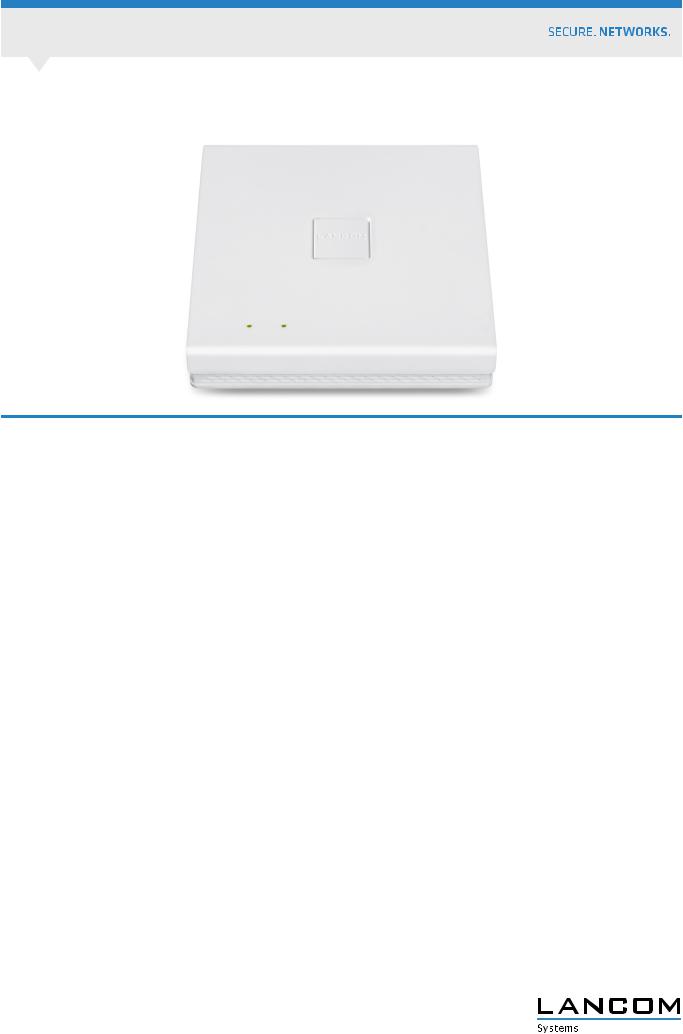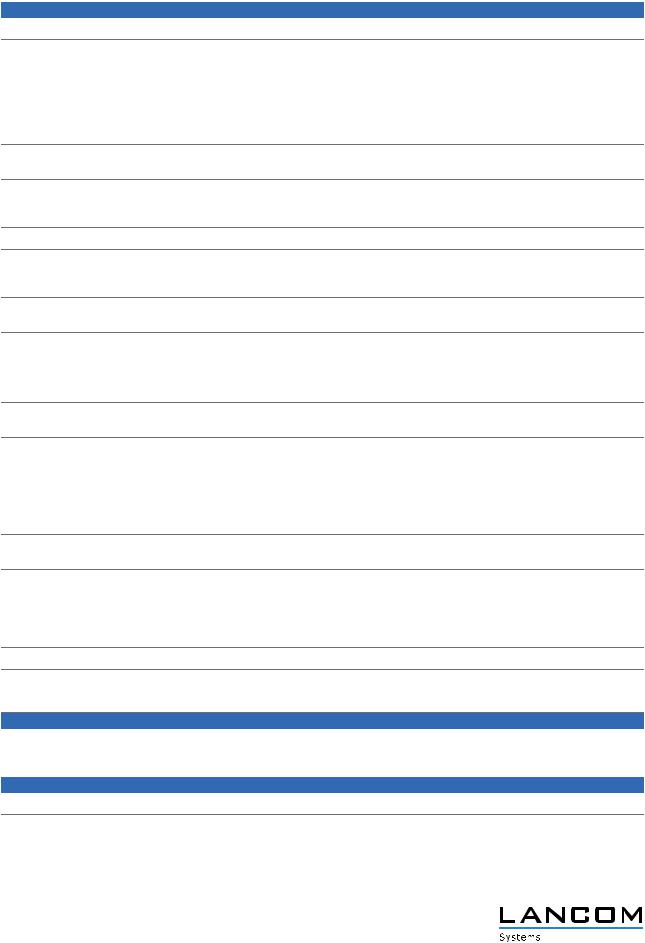Lancom LN-830acn User Manual

Wireless LAN
LANCOM LN-830acn dual Wireless
Dual radio enterprise-class 11ac WLAN access point in elegant design with up to 867 Mbps
The LANCOM LN-830acn dual Wireless is a powerful 11ac WLAN enterprise-class access point. It provides fast WLAN to 11n clients in the 2.4-GHz frequency band and also to the increasing number of modern 11ac-enabled devices in the 5-GHz band. Thanks to its puristic and elegant design it is ideal for an inconspicuous application in modern environments.
aDual concurrent WLAN – parallel operation at 2.4 and 5 GHz with up to 867 Mbps with IEEE 802.11ac
aDynamic WLAN optimization thanks to LANCOM Active Radio Control (ARC)
aPowerful WLAN diagnostics with Spectral Scan
aProfessional security features such as IEEE 802.1X
aZero-touch deployment with a LANCOM WLAN controller or LSR
aEasy and secure integration of external users with the Public Spot Option
aElegant LANCOM design with integrated antennas and hidden cable connectors

DATASHEET
LANCOM LN-830acn dual Wireless
Dual concurrent WLAN with up to 867 Mbps
The LANCOM LN-830acn dual Wireless offers one wireless radio module for 11ac WLAN and another for 11n WLAN. This provides fast WLAN to 11n clients in the 2.4-GHz frequency band and also the increasing number of modern 11ac-enabled devices in the 5-GHz band.
Active Radio Control for dynamic radio-field
optimization
The LANCOM LN-830acn dual Wireless supports the WLAN optimization feature LANCOM Active Radio Control. This intelligent combination of innovative features included with the LCOS operating system – such as Band Steering, Adaptive Noise Immunity, RF Optimization, and Client Steering – sustainably increases WLAN performance and supports administrators with professional tools for WLAN management.
Powerful WLAN diagnostics with Spectral Scan
The LANCOM LN-830acn dual Wireless uses the Spectral Scan to search the surrounding radio field for sources of interference. This professional tool for efficient WLAN troubleshooting is a combination of hardware and software features. It identifies and graphically represents sources of interference, so helping the administrator to initiate countermeasures.
LANCOM security for wireless networks
With numerous integrated security features, such as IEEE 802.1X, this enterprise-class access point provides optimal security for networks. As a result, employees and visitors all benefit from security policies in the network.
Support for zero-touch deployment
By supporting zero-touch deployment, the LANCOM LN-830acn dual Wireless is quickly and easily integrated and configured without having to access the configuration UI. In installations operated by a WLAN controller or LSR the access point receives an appropriate configuration immediately after network authentication.
Secure integration of external users
In combination with the LANCOM Public Spot Option, the LANCOM LN-830acn dual Wireless is ideal for operating hotspots. Users benefits from a hotspot that is secure and easy-to-use, while hotspot operators can be sure that their own network remains separate from the hotspot.
Elegant LANCOM design
The white LANCOM LN-830acn dual Wireless with integrated antennas stands out with its puristic elegance. Thanks to the modern design it is ideal for an inconspicuous application in environments of every industry sector and seamlessly fits into every environment.
Maximum future-proofing
The LANCOM LN-830acn dual Wireless supports what is currently the fastest WLAN standard, so that customers are well prepared for future challenges. What's more, LANCOM products are designed for a service life of several years and are equipped with hardware dimensioned for the future. Even reaching back to older product generations, updates to the LANCOM Operating System – LCOS – are available several times a year, free of charge and offering major features.

 DATASHEET
DATASHEET
LANCOM LN-830acn dual Wireless
LCOS 9.18
WLAN product specifications
Frequency band 2.4 GHz and 5 GHz |
2400-2483.5 MHz (ISM) and 5150-5700 MHz (depending on country-specific restrictions) |
Integrated Antenna Gain (per antenna (2)) up to 3 dBi in 2.4 GHz, up to 4.5 dBi in 5 GHz |
|
Data rates IEEE 802.11ac/n |
867 Mbps according to IEEE 802.11ac with MCS9 (fallback to 6,5 Mbps with MCS0). Compatible to IEEE 802.11ac/n/a, IEEE 802.11 |
|
ac/n, IEEE 802.11n/a compatibility mode or pure IEEE 802.11ac, pure IEEE 802.11n, pure IEEE 802.11a mode and data rates selectable |
Data rates IEEE 802.11n |
300 Mbps according to IEEE 802.11n with MCS15 (fallback to 6,5 Mbps with MCS0). Compatible to IEEE 802.11a/n, IEEE 802.11g/n, |
|
IEEE 802.11b/g/n or IEEE 802.11b/g compatibility mode or pure IEEE 802.11n, pure IEEE 802.11a, IEEE 802.11g or pure IEEE 802.11b |
|
mode and data rates selectable |
Data rates IEEE 802.11a/ h |
54 Mbps (fallback to 48, 36 , 24, 18, 12, 9, 6 Mbps, Automatic Rate Selection), fully compatible with TPC (adjustable power output) |
|
and DFS (automatic channel selection, radar detection) and data rates selectable |
Data rates IEEE 802.11b/g |
54 Mbps to IEEE 802.11g (fallback to 48, 36, 24, 18, 12, 9, 6 Mbps, Automatic Rate Selection) compatible to IEEE 802.11b (11, 5.5, |
|
2, 1 Mbps, Automatic Rate Selection), IEEE 802.11b/g compatibility mode or pure IEEE 802.11g or pure IEEE 802.11b and data rates |
|
selectable |
Range IEEE 802.11a/b/g * |
Up to 150 m (up to 30 m in buildings) |
Output power at radio module WLAN-1, 5 IEEE 802.11a/h: +17 up to +18 dBm @ 6 up to 48 Mbps, +13 up to +15 dBm @ 54 Mbps, IEEE 802.11n: +17 up to +18 dBm @ GHz (MCS0/8/16, 20 MHz), +11 up to +13 dBm @ (MCS7/15/23, 20 MHz), +16 up to +17 dBm @ (MCS0/8/16, 40 MHz), +9 up to +12 dBm
@ (MCS7/15/23, 40 MHz)
Output power at radio module WLAN-2, 5 IEEE 802.11a/h: +18 dBm @ 6 up to 48 MBit/s and +16 dBm @ 54 MBit/s IEEE 802.11ac: +16 up to +18 dBm @ (MCS0-7, 20/40/80 GHz MHz), +14 dBm @ (MCS8, 20/40/80 MHz), +14 dBm @ (MCS9, 40/80 MHz)
Output power at radio module WLAN-1, IEEE 802.11b: +22 dBm @ 1 and 2 Mbps, +22 dBm @ 5,5 and 11 Mbps, IEEE 802.11g: +22 dBm @ 6 up to 36 Mbps, +20 dBm @ 48
2.4 GHz |
Mbps, +18 dBm @ 54 Mbps, IEEE 802.11n: +22 dBm @ (MCS0/8/16, 20 MHz), +16 dBm @ (MCS7/15/23, 20 MHz), +21 dBm @ |
|
(MCS0/8/16, 40 MHz), +15 dBm @ (MCS7/15/23, 40 MHz) |
Minimum transmission power |
Transmission power reduction in software in 1 dB steps to min. 0.5 dBm |
Receiver sensitivity WLAN-1, 5 GHz |
IEEE 802.11a/h: -98 dBm @ 6 Mbps, -81 dBm @ 54 Mbps, IEEE 802.11n: -94 dBm @ (MCS0, 20 MHz), -76dBm @ (MCS 7, 20 MHz), |
|
-92 dBm @ (MCS0, 40 MHz), -72 dBm @ (MCS7, 40 MHz) |
Receiver sensitivity WLAN-2, 5 GHz |
IEEE 802.11a/h: -95 dBm @ 6 MBit/s, -76 dBm @ 54MBit/s, IEEE 802.11ac: -94 dBm @ MCS0 20 MHz, -76 dBm @ MCS7 20 MHz, -72 |
|
dBm @ MCS8 20 MHz, -92 dBm @ MCS0 40 MHz, -76 dBm @ MCS7 40 MHz, -71 dBm @ MCS8 40 MHz, -70 dBm @ MCS9 40 MHz, |
|
-90 dBm @ MCS0 80 MHz, -72 dBm @ MCS7 80 MHz, -68 dBm @ MCS8 80 MHz, -67 dBm @ MCS9 80 MHz |
Receiver sensitivity WLAN-1, 2.4 GHz |
IEEE 802.11b: -97 dBm @ 1 MBit/s, -93 dBm @ 11 MBit/s, IEEE 802.11g: -95dBm @ 6 MBit/s, -81dBm @ 54 MBit/s IEEE 802.11n: -94 |
|
dBm @ 6,5MBit/s (MCS0, 20 MHz), -77 dBm @ 65 MBit/s (MCS7, 20 MHz), -91 dBm @ 15 MBit/s (MCS0, 40 MHz), -74 dBm @ 150 |
|
MBit/s (MCS7, 40 MHz) |
Radio channels 5 GHz |
Up to 26 non-overlapping channels (available channels and further obligations such as automatic DFS dynamic channel selection |
|
depending on national regulations) |
Radio channels 2.4 GHz |
Up to 13 channels, max. 3 non-overlapping (depending on country-specific restrictions) |
Multi-SSID |
Up to 31 (Simultaneous use of up to 16 independent WLAN networks at WLAN interface 1 and up to 15 independent WLAN networks |
|
at WLAN interface 2. |
Concurrent WLAN clients |
Up to 200 clients (recommended), 512 clients (max.)** |
Others |
Wireless Quality Indicators (WQI) |
*) Note |
The effective distances and transmission rates that can be achieved are depending of the onsite RF conditions |
**) Note |
The 11ac WLAN module supports max. 128 clients, this specification refers to the combination with the 11n radio module. |
Supported WLAN standards |
|
IEEE standards |
IEEE 802.11ac, IEEE 802.11n, IEEE 802.11a, IEEE 802.11g, IEEE 802.11b, IEEE 802.11i, IEEE 802.1X, IEEE 802.11u, IEEE 802.11r (Fast |
|
Roaming), IEEE 802.11w (Protected Management Frames), WME and U-APSD/WMM Power Save as defined in IEEE 802.11e, IEEE |
|
802.11h, IEEE 802.11d |
Standard IEEE 802.11ac |
|
Supported features |
2x2 MIMO, 80 MHz channels, QAM-256 |
